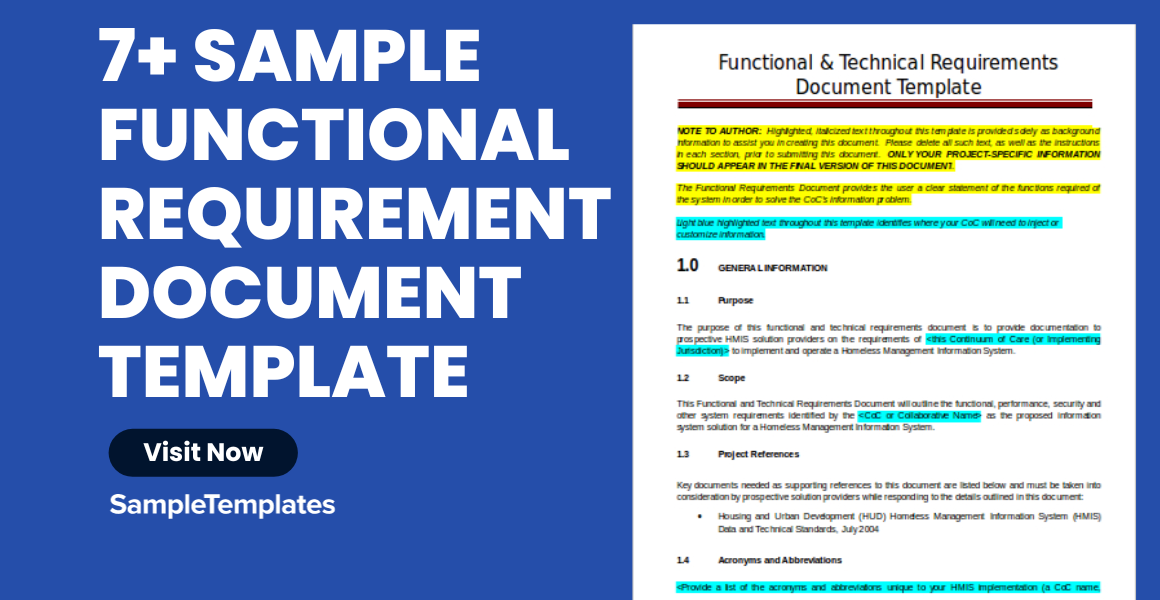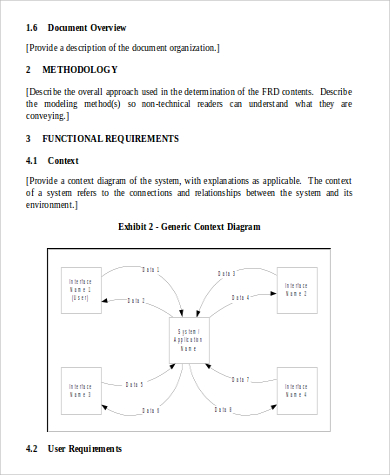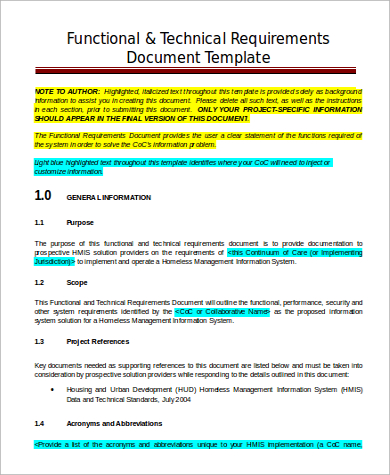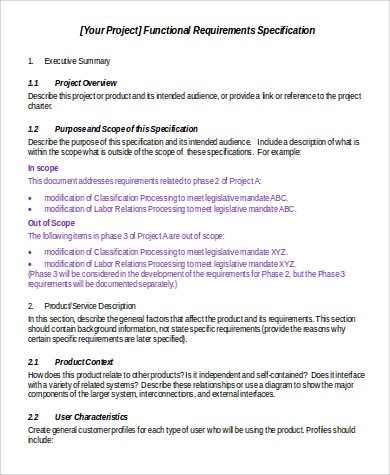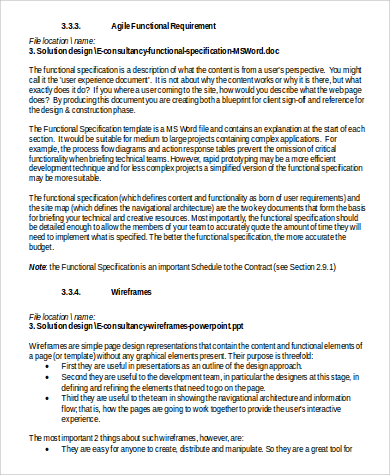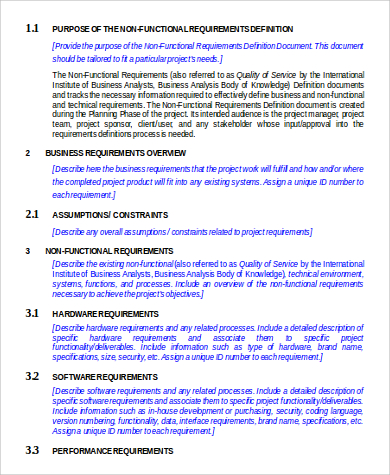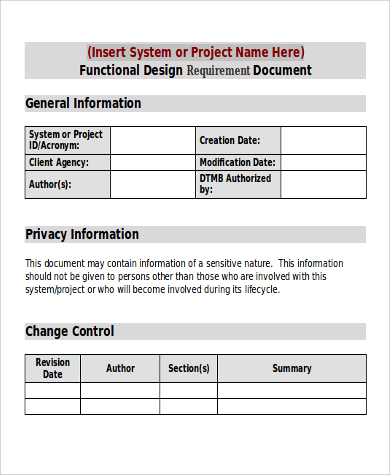Are you wondering what a functional requirements document or what an FRD is? According to the internet, a functional requirements document, abbreviated as FRD, is a formal statement of an application’s functional requirements. The developers agree to provide the capabilities being specified. The client agrees to find a product satisfactory if it provides the capabilities specified in the functional requirements document. It would also serves the same purpose as a sample contract or an agreement.
Perhaps having a look or browsing through these Business Document can definitely help you through providing a variety of different perspectives as well as a handful of insights.
1. Business Functional Requirements Document Template
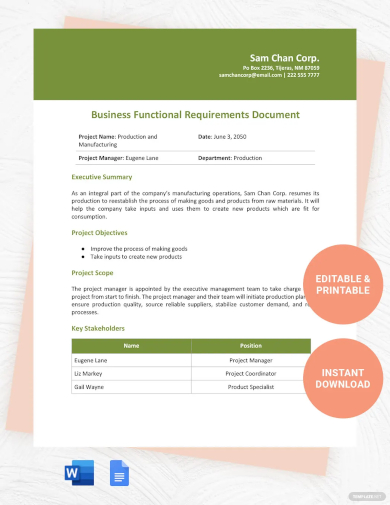
2. Functional Requirement Document in DOC
3. Functional and Technical Requirements Document
4. Functional Business Requirement Document Template
How do I write a FRS document?
A Financial Reporting Standard (FRS) document is a comprehensive and structured accounting framework that provides guidelines for financial reporting. It ensures consistency, transparency, and comparability in financial statements across different entities. Here is a detailed guide on how to write a FRS document:
Title and Introduction:
- Title: Begin with a clear and concise title indicating that the document is a Financial Reporting Standard.
- Introduction: Provide a brief overview of the purpose statement and scope of the FRS. Mention any relevant regulatory bodies or standards-setting organizations influencing the FRS.
Objective: 3. Objective Statement: Clearly state the main objective of the FRS. This could be to enhance transparency, improve comparability, or address specific financial reporting issues.
Scope: 4. Scope Definition: Define the boundaries of the FRS. Specify the types of entities, industries, or transactions covered. Also, outline what is excluded from the FRS.
Framework: 5. Conceptual Framework: Establish the conceptual framework guiding the FRS. This includes fundamental principles such as relevance, reliability, comparability, and consistency.
Financial Statement Presentation: 6. Balance Sheet (Statement of Financial Position): Detail the requirements for presenting assets, liabilities, and equity. Specify classifications, order of presentation, and any specific disclosures.
- Income Statement (Statement of Comprehensive Income): Outline guidelines for presenting revenues, expenses, gains, and losses. Address issues like extraordinary items or discontinued operations.
- Cash Flow Statement: Provide instructions for preparing the statement of cash flows statement, including the classification of cash flows into operating, investing, and financing activities.
Recognition and Measurement: 9. Recognition Criteria: Define the criteria that must be met for an item to be recognized in the financial statements. Address issues like historical cost, fair value, and probability of future economic benefits.
- Measurement Bases: Specify the measurement bases to be used (e.g., cost model, revaluation model). Clarify when fair value measurement is appropriate.
Disclosure Requirements: 11. General Disclosures: Outline general disclosure requirements applicable to all entities following the FRS.
- Specific Disclosures: Provide detailed instructions on disclosures specific to certain transactions or industries.
Implementation Guidelines: 13. Transition Provisions: Detail how entities should transition from previous accounting policies to the new FRS.
- Effective Date: Specify the date from which the FRS becomes effective.
Review and Approval Process: 15. Review Process: Describe the process for reviewing and updating the FRS as needed.
- Approval: Clearly state the authority responsible for approving the FRS.
Appendices: 17. Examples and Illustrations: Include practical examples and illustrations to help users understand the application of the FRS.
References: 18. Citations: Provide sample references to relevant accounting standards, legal requirements, or other authoritative sources.
5. Functional Specification Requirement Document Template
6. Sample Agile Functional Requirement Document Template
You can also have a look at this page’s Sample Business Requirements Documents, which can absolutely be useful as well as helpful for you in terms of the subject matter, which in this case is the functional requirements document. Since quality is meeting requirements, the functional requirements documents is the central document as well as an agreement in the system development.
It is also used for the following:
- Evaluating the product in all subsequent phases of the life cycle
- Determining the success of the project
- Designing and developing tile application system
The Characteristics of a Functional Requirements Document
- The functional requirements documents demonstrate that the certain sample application would provide value to the state regarding the terms of the business objectives as well as the business processes in the 5-year plan.
- The functional requirements documents include a whole set of complete requirements for the application, which leaves no room for anyone whatsoever for assuming anything that is stated in the functional requirements document.
- The FRD or functional requirements document is also solution independent. Unlike the entity relationship diagram or the ERD, which would cover what a certain software application is to do, the FRD does not commit the developers to a design review. And based on that, any reference to the eventual use of a specific technology is completely not applicable as well as it is not appropriate in an FRD.
7. Non-Functional Requirement Document Outline Template
What is functional requirements examples?
Functional requirements are specifications that describe the functions a system or product must perform to meet the intended user needs and achieve its objectives. Here are examples across various domains:
1. User Authentication:
- Requirement: The system must allow users to create accounts, log in securely, and reset passwords.
- Example: Users should be able to register with a valid email, create a password, and receive a confirmation email.
2. Data Entry and Validation:
- Requirement: The system must allow users to input and validate data.
- Example: When a user enters a date, the system should validate it to ensure it follows the specified format and falls within an acceptable range.
3. System Security:
- Requirement: The system must implement security measures to protect user data.
- Example: The system should encrypt sensitive information, and only authorized users with the correct permissions can access or modify data.
4. Reporting:
- Requirement: The system must generate predefined and custom reports sample.
- Example: Users should be able to generate a monthly sales report with options to filter data by date, region, or product category.
5. Search and Retrieval:
- Requirement: The system must provide a search functionality for users to find specific information.
- Example: Users should be able to search for products by name, category, or price range.
6. Payment Processing:
- Requirement: The system must support secure online payment processing.
- Example: Users should be able to enter credit card information, and the system should validate, process, and confirm successful transactions.
7. Compatibility:
- Requirement: The system must be compatible with various devices and browsers.
- Example: The system should be accessible and function seamlessly on popular web browsers such as Chrome, Firefox, and Safari.
8. Performance:
- Requirement: The system must perform efficiently under normal and peak loads.
- Example: The response time for user actions, like clicking a button or loading a page, should not exceed three seconds under typical usage conditions.
9. Notifications:
- Requirement: The system must send notifications to users based on specific events.
- Example: Users should receive email notifications for order confirmations, shipment updates, and account activity.
10. Accessibility: – Requirement: The system must adhere to accessibility standards to accommodate users with disabilities. – Example: The system should provide alternative text for images, keyboard navigation options, and compatibility with screen readers.
11. Integration: – Requirement: The system must integrate with third-party applications or services. – Example: The system should seamlessly integrate with a customer relationship management (CRM) system to sync customer data.
These examples illustrate how functional requirements specify the features and capabilities of a system, ensuring that it meets the needs of its users and stakeholders.
8. Formal Functional Design Requirement Document
A requirement is a condition that the application must meet for the customer to find the sample application satisfactory. A requirement has the following characteristics:
- It provides a benefit to the organization.
- It describes the capabilities the application must provide in business terms ad conditions.
- It does not describe how the application provides that capability.
- It does not describe such design considerations as computer hardware, operating system, and database design.
- It is stated in unambiguous words. Its meaning is clear and understandable.
- It is verifiable.
What Are Things That are Included in the Functional Requirements Document?
- Lists of who can be able to enter the data into the system
- System reports and other outputs’ descriptions
- Descriptions of the work flows that are performed by the system
- Descriptions of any operations which are performed by each screen
- Data descriptions of which is usually entered into the system
Furthermore, you can also have a look at these Sample Tender Documents, which you might find rather useful as well as helpful in terms of the subject matter.
What is difference between BRD and FRD?
Related Posts
Retirement Speech Samples & Templates
Weekly Schedule Samples & Templates
Contractual Agreement Samples & Templates
FREE 9+ Amazing Sample Church Bulletin Templates in PSD | PDF
Sample Business Card Templates
Sample Cashier Job Descriptions
Questionnaire Samples
FREE 10+ Sample HR Resource Templates in PDF
FREE 49+ Sample Job Descriptions in PDF | MS Word
FREE 23+ Sample Event Calendar Templates in PDF | MS Word | Google Docs | Apple Pages
Company Profile Samples
FREE 10+ Leadership Report Samples [ Development, Training, Camp ]
FREE 24+ Sample Payment Schedules in PDF | MS Word
FREE 10+ Return to Work Action Plan Samples in PDF | DOC
Autobiography Samples & Templates
